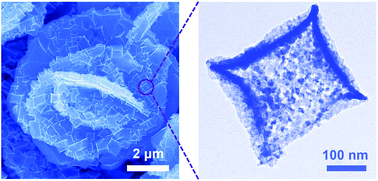Prussian blue analogue-derived Ni and Co bimetallic oxide nanoplate arrays block-built from porous and hollow nanocubes for the efficient oxygen evolution reaction†
Abstract
Effective oxygen evolution reaction (OER) catalysts composed of Earth-abundant transition metals are crucial for sustainable energy conversion and storage. Metal–organic frameworks (MOFs) with tunable compositions are promising precursors for the fabrication of hollow and porous electrocatalysts. However, pulverous MOFs usually suffer from agglomeration during pyrolysis, greatly reducing the activity of their derived catalysts. In this work, Prussian blue analogue (PBA) arrays with hierarchical multidimensional architecture were directly grown on nickel foam (NF) using a template-oriented method. The subsequent calcination in air allowed for obtaining NixCo3–xO4 nanoplate arrays consisting of porous and hollow nanocubes. The derived bimetallic NixCo3−xO4/NF required only an overpotential of 287 mV to achieve a current density of 10 mA cm−2 in 1.0 M KOH solution, which is much lower than that of the monometallic NiO and the RuO2 benchmark. The 3D intersectional architecture of the NixCo3−xO4 nanoplates and the porous and hollow nanocube subunits contributed to the large specific surface area and reduced charge-transfer resistance of the NixCo3−xO4/NF electrode. Density functional theory (DFT) calculations and post-OER characterization revealed that the incorporated Co was the active sites and electrochemical active CoOOH intermediates were in situ formed during the OER. Our study provides a facile and efficient strategy for the rational design of MOF-derived materials towards effective and low-cost electrocatalysis.



 Please wait while we load your content...
Please wait while we load your content...